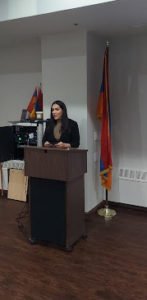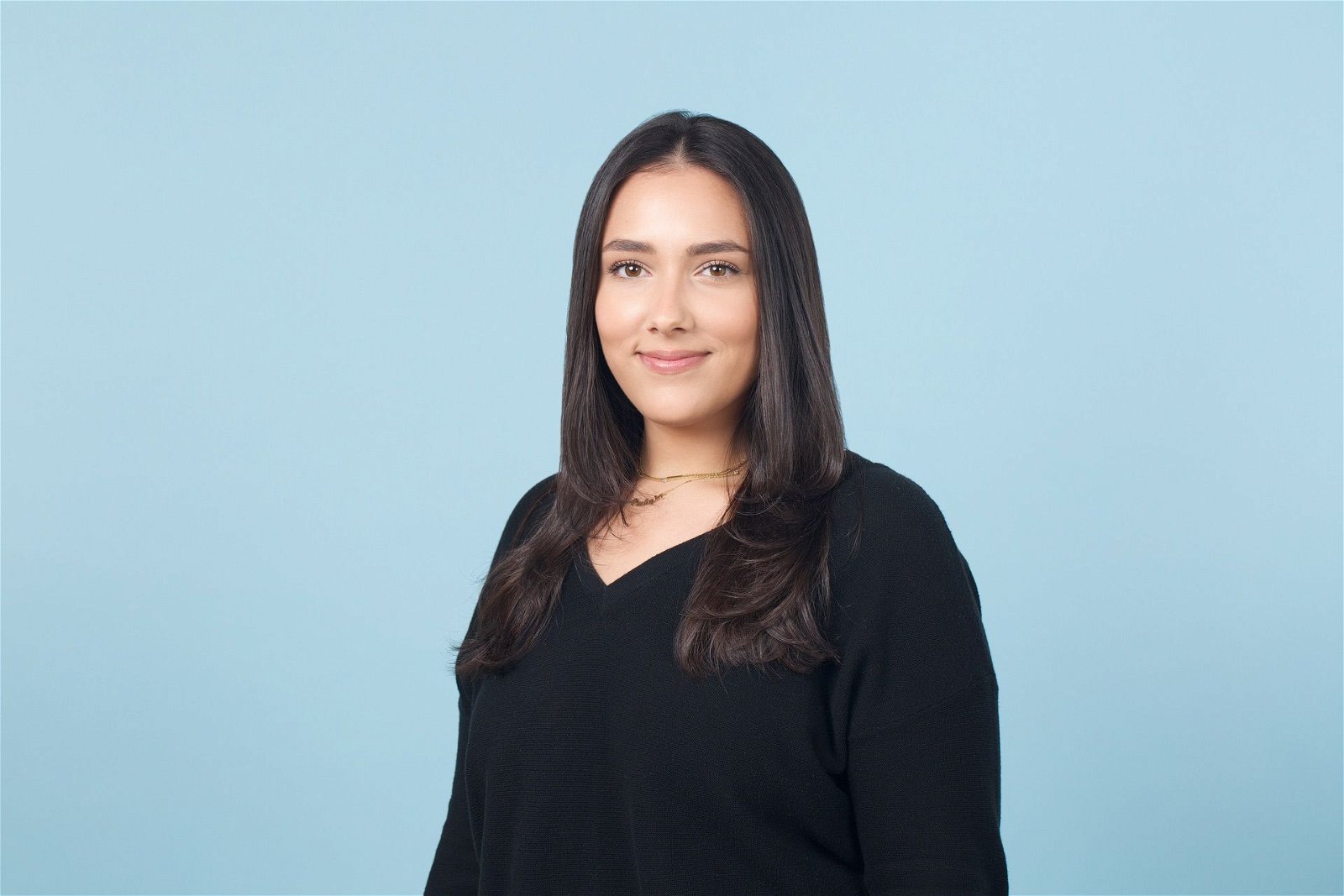Editor’s Note: The following remarks were delivered by the author during an Armenian Genocide Commemoration program hosted by the AYF at St. Sarkis Church on Saturday, April 23, 2022.

Some of my earliest childhood memories are about not wanting to be Armenian — embarrassed that none of my classmates could point to Armenia on a map, concealing my school lunches that consisted of lahmajun or seenee kufteh, and instead, opting for a bland school lunch because I wanted to “fit in.” I often remember the other students in my class assuming I was Italian or Greek, and I wouldn’t correct them because the thought of having to explain that Albania was not the same country as Armenia, for the 500th time, made me sick to my stomach.
My childhood aspirations of wanting to “fit in” soon morphed my reality into a double life—one that was American and one that was Armenian. I almost never shared the Armenian part of my life with “outsiders,” as I always felt that they would never understand. They would never understand that the Armenian mountain peaks of Ararat, which define my heritage, reside on the soil of my enemies. They would never understand that my homeland is fragmented. They would never understand the plight of Armenians. They would never understand that 1.5 million is not just a number, but a constant reminder that we are still fighting for justice.
When I reflect on the journey my father and mother embarked on to come to the United States to build a better life, my grandparents who don’t speak English but managed to raise children and grandchildren in a foreign country, my great-grandparents who survived Genocide waking each day uncertain of their fate, I am reminded that I had it all wrong. I was never embarrassed of my Armenian-ness. I was disappointed that others did not understand what being Armenian truly meant. This realization was a turning point in my adolescent life. This was the moment I vowed to share my Armenian history any chance I could, to any and every one who would listen.
I have a distinct memory of the first time I understood the weight that came with being Armenian. In late 2003, my Armenian Catholic Church of St. Ann’s, on E. 12th street on the Lower East Side of Manhattan was seized by Cardinal Eagan of the New York Diocese. This Armenian church was home to me. It witnessed the marriage of my mother and father, the countless baptisms of my cousins and the celebratory gatherings brought by each holiday season. I was seven years old when my weekends were scheduled with rallies and protests outside of the Archdiocese of New York, making claims “don’t forget about the Armenians.” This feeling is one that I deeply connect to my ancestral story.
Both my father and mother have countless recollections and stories passed through generations a dozen times over, of how we came to be…how we came to be Armenian, how we came to live in the United States, and how we came to carry our last names filled with decades of history.
The story of my paternal great-great-great-grandfather was one I always heard as a child. He was crowned with the nickname “Mushagga” – coming from the once Armenian province, Mush. Having existed during the same time as the Assyrian Genocide of 1890 in parts of Mardin, Elia Mouchacca, like many other Christians of his time, lived in fear—fear that he would be slaughtered for simply wearing a cross around his neck. Elia married and remained in Mardin, where he had many children and grandchildren. One of his grandchildren, Garabed, is my great-grandfather. Born in 1897, he worked throughout his childhood on the family land. After a long day’s work, Garabed returned home in a panic telling his father that he witnessed people in their village being killed in pure daylight by men on horses. To my great-great grandfather’s disbelief, he told his son it must have been a bad dream. Three days later, my great-great-grandfather was killed in his home, bearing witness to his entire family. My great-grandfather, at 14 years old, was able to escape to a neighbor’s house, hiding in an underground tandoor oven for two weeks. He then traveled alone by foot, following train tracks to the border of Syria. It was in Qamishli that he recognized his grandmother, and both found their way to Baalbek, Lebanon.
Similar trials and tribulations were faced by my maternal side. My great-great-aunt Zekia Zekert was born in 1880, also in Mardin, where she married and had two sons. During the genocidal death march, Zekia was witness to the abduction of her husband and the killing of her two boys by the Ottoman Turks. The torture for her continued as they gruesomely cut off her two breasts, leaving her to die. Or so they thought… Zekia went on to survive the bloodshed and loss of her family. A Kurdish man stumbled upon her suffering and brought her in, nursing her back to health. She continued to live with him for a few short years, cooking, cleaning and tending to his home as compensation for saving her life. One afternoon, she went out to fetch water from a well, and she was spotted by a Kurdish man who used to work for her father. Through this encounter, Zekia was reunited with her father back in Mardin. She later moved to Zahle, Lebanon where she remarried and had more children of her own. Zekia had 14 other siblings, of which, only four survived.
While these are only a few accounts of the experiences of my ancestors, they share a lot in common. The only choice was survival. The only motivation was family and legacy. When I think of my priorities as an Armenian, the same applies. I do not afford myself the choice to attend a protest, to speak Armenian, to hold membership in our diasporan community, or to teach others of where Armenia is on a map. It is my duty. Past generations were tasked with freeing Armenia from the shackles of the Soviet Union in 1990. Today’s generation is responsible for establishing a free, united and independent Armenia. The conservation of this freedom and the responsibility of uniting Artsakh with present-day Armenia is not a choice. Imagine a Stepanakert, Martuni, Martakert that is part of Azerbaijan. Where are the Armenians of Baku? Sumgait? Kirovabad? What happened to Western Armenia? Desecrated churches, historic sites, cathedrals and monuments. Once deemed as Armenian towns and villages are now left with nothing but layers of dust and ash.
Being Armenian means that when all odds were against us, we managed to rebuild, recreate and survive.
Being Armenian is not easy. It comes with dark memories, hopelessness and unimaginable loss. But being born Armenian also means that pride and courage is entangled in our DNA. It means that the blood pumping through our veins is of three colors, not one. Being Armenian means that when all odds were against us, we managed to rebuild, recreate and survive. Our music, dance, culture, food, Christianity, all continue to live on. We are authors, curators, musicians, textile masters, diplomats, lawyers and surgeons. We are known for far more than the Armenian Genocide of 1915.
Today, I stand before you all, a descendant of many Genocide survivors, of the Nasri, Bedrossian, Mouchacca and Zekert legacies. I am a cross of multiple lineages, not one less resilient, powerful, or braver than the other. Today, I stand before you all, of a different mindset than my younger self. I am a proud member of the AYF and of the ANCA. I am a proud Armenian who has since traveled to Armenia having seen Datev, Noravank, Khor Virap, Ghazanchetsots with my own eyes, the first of my family’s generation to step foot on Artsakh and Javakhk soil, learned to speak Armenian, cook Armenian, and most importantly, learned to be Armenian.
The fate of our homeland lies within each of us. The unity of our homeland lies within us. The determination of our youth lies within us. Delivering justice and reparations for the Armenian Genocide 107 years later lies within us. Do not lose sight of your Armenian-ness. It should be the part of us that shines brightest. Like our ancestors, we must continue to survive, so send your children to Armenian schools, speak the language, cook the food, attend Armenian churches, share the stories of your ancestors, attend protests and community events, volunteer your time, and visit Armenia. Because after all, this is what being Armenian truly means.



Dear Chantelle, this is a beautiful story. I stumbled upon this reflection after trying to answer this question myself. Thank you for sharing.